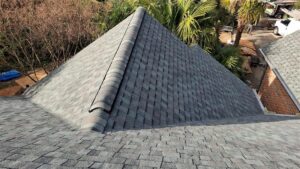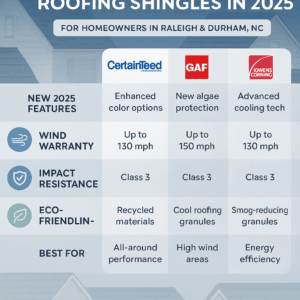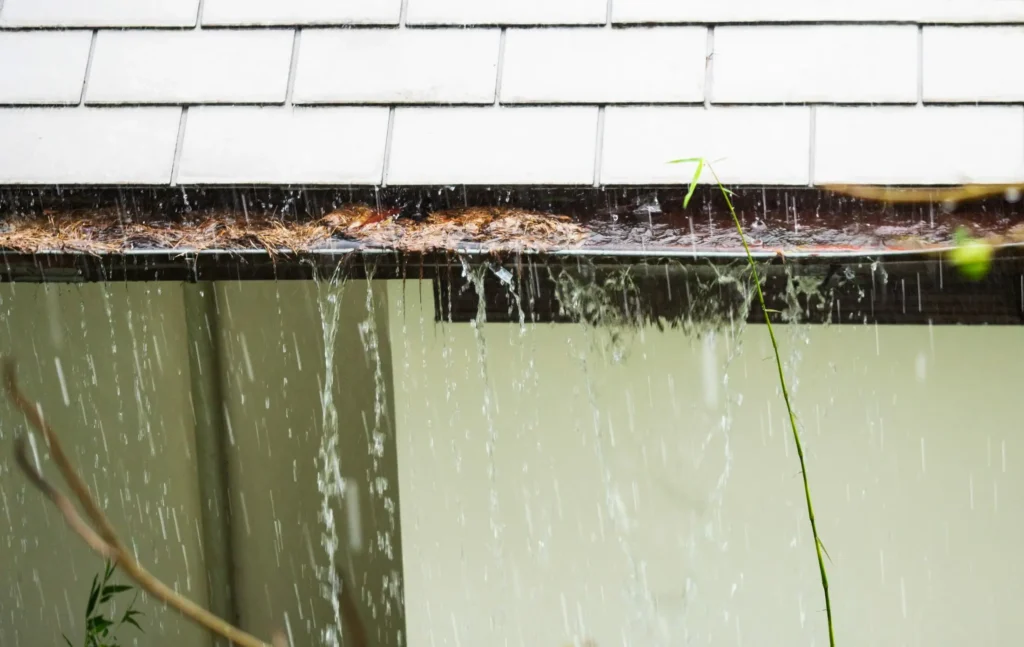
Clogged Gutters
- Signs:
- Overflowing Water: During heavy rain, water spills over the sides of gutters.
- Standing Water: Water pools around the foundation or near the eaves.
- Stains on Exterior Walls: Look for streaks or discoloration on the siding.
-
- Use a Moisture Meter: A tool that measures moisture levels in walls and floors can help find hidden leaks.
-
- Visual Inspections: Regularly check areas prone to leaks, especially after heavy rains or snow melt.
-
- Listen for Sounds: Dripping or running water can show a leak, especially in quiet spaces like basements.
- Check Utility Meters: Watch your water meter for unexplained changes that suggest a leak.
- What to Check:
-
- Inspect exterior grading to make sure water drains away from the foundation.
- Look for signs of soil erosion or pooling around the house.
-
Tips for Effective Leak Detection
-
- Use a Moisture Meter: A tool that measures moisture levels in walls and floors can help find hidden leaks.
-
- Visual Inspections: Regularly check areas prone to leaks, especially after heavy rains or snow melt.
-
- Listen for Sounds: Dripping or running water can show a leak, especially in quiet spaces like basements.
- Check Utility Meters: Watch your water meter for unexplained changes that suggest a leak.
- What to Check:
-
- Inspect exterior grading to make sure water drains away from the foundation.
- Look for signs of soil erosion or pooling around the house.
-
Tips for Effective Leak Detection
-
- Use a Moisture Meter: A tool that measures moisture levels in walls and floors can help find hidden leaks.
-
- Visual Inspections: Regularly check areas prone to leaks, especially after heavy rains or snow melt.
-
- Listen for Sounds: Dripping or running water can show a leak, especially in quiet spaces like basements.
- Check Utility Meters: Watch your water meter for unexplained changes that suggest a leak.
-
- Signs:
-
- Musty Odor: Persistent damp smells can show moisture issues.
-
- Cracks in Walls or Floors: Look for visible cracks in the foundation or basement walls.
-
- Puddles or Dampness: Notice any standing water or moisture on the floor.
-
- Signs:
- What to Check:
-
- Inspect exterior grading to make sure water drains away from the foundation.
- Look for signs of soil erosion or pooling around the house.
-
Tips for Effective Leak Detection
-
- Use a Moisture Meter: A tool that measures moisture levels in walls and floors can help find hidden leaks.
-
- Visual Inspections: Regularly check areas prone to leaks, especially after heavy rains or snow melt.
-
- Listen for Sounds: Dripping or running water can show a leak, especially in quiet spaces like basements.
- Check Utility Meters: Watch your water meter for unexplained changes that suggest a leak.
- What to Check:
-
- Inspect weather stripping and seals for damage.
- Check for warped frames or improperly installed units.
-
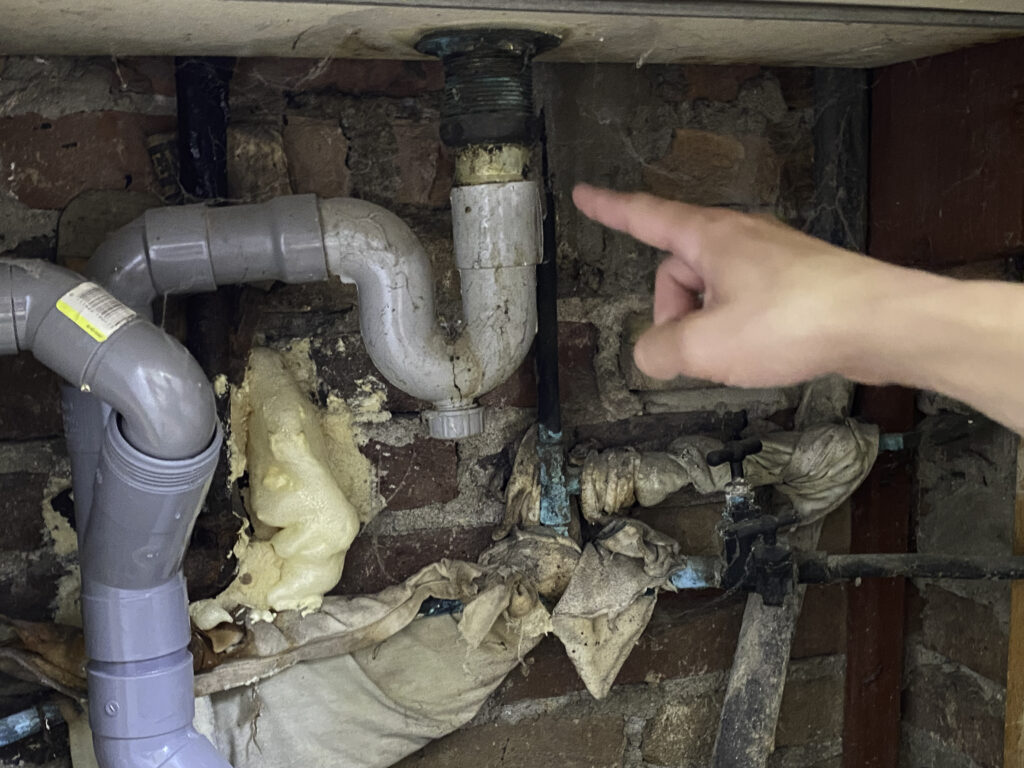
Plumbing Issues
-
- Signs:
-
- Water Stains on Ceilings or Walls: Discoloration can show a leak in the plumbing above.
-
- Damp or Moldy Spots: Unusual moisture near fixtures or on walls.
-
- Unexplained Water Bills: A sudden increase shows a hidden leak.
-
- Signs:
-
- What to Check:
-
- Inspect visible pipes for corrosion or leaks.
-
- Check under sinks and behind appliances for pooling water.
-
- What to Check:
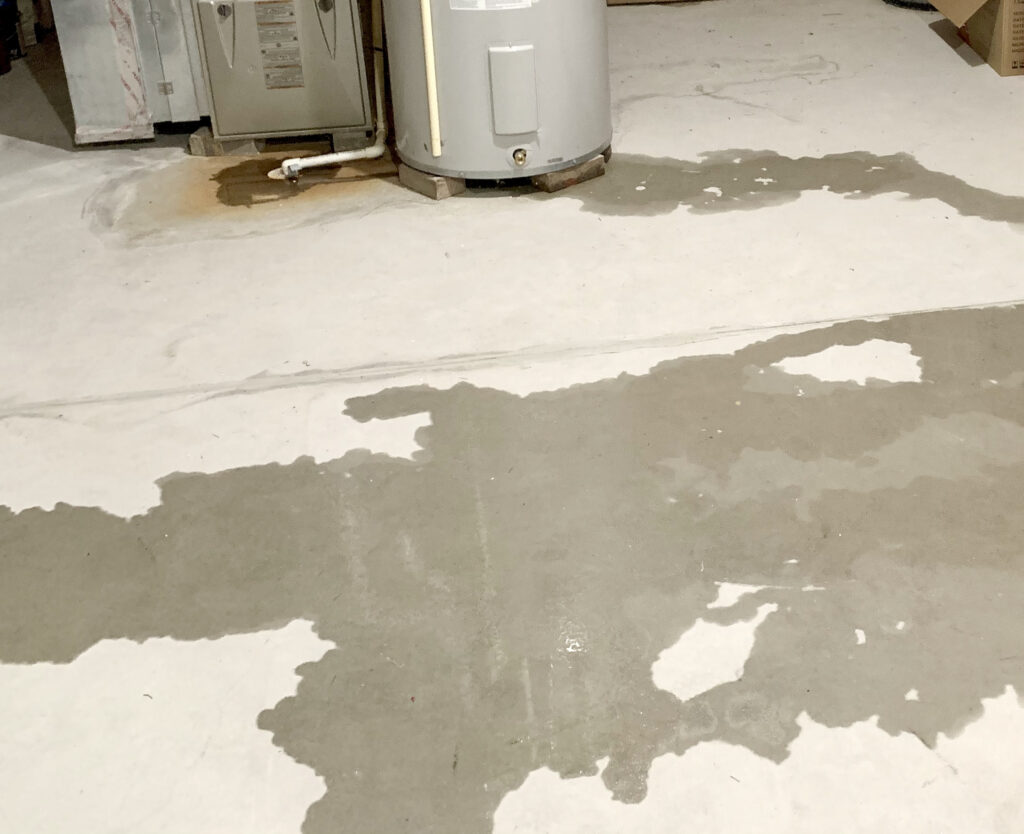
Basement Seepage
-
- Signs:
-
- Musty Odor: Persistent damp smells can show moisture issues.
-
- Cracks in Walls or Floors: Look for visible cracks in the foundation or basement walls.
-
- Puddles or Dampness: Notice any standing water or moisture on the floor.
-
- Signs:
- What to Check:
-
- Inspect exterior grading to make sure water drains away from the foundation.
- Look for signs of soil erosion or pooling around the house.
-
Tips for Effective Leak Detection
-
- Use a Moisture Meter: A tool that measures moisture levels in walls and floors can help find hidden leaks.
-
- Visual Inspections: Regularly check areas prone to leaks, especially after heavy rains or snow melt.
-
- Listen for Sounds: Dripping or running water can show a leak, especially in quiet spaces like basements.
- Check Utility Meters: Watch your water meter for unexplained changes that suggest a leak.
- What to Check:
-
- Inspect weather stripping and seals for damage.
- Check for warped frames or improperly installed units.
-

Plumbing Issues
-
- Signs:
-
- Water Stains on Ceilings or Walls: Discoloration can show a leak in the plumbing above.
-
- Damp or Moldy Spots: Unusual moisture near fixtures or on walls.
-
- Unexplained Water Bills: A sudden increase shows a hidden leak.
-
- Signs:
-
- What to Check:
-
- Inspect visible pipes for corrosion or leaks.
-
- Check under sinks and behind appliances for pooling water.
-
- What to Check:

Basement Seepage
-
- Signs:
-
- Musty Odor: Persistent damp smells can show moisture issues.
-
- Cracks in Walls or Floors: Look for visible cracks in the foundation or basement walls.
-
- Puddles or Dampness: Notice any standing water or moisture on the floor.
-
- Signs:
- What to Check:
-
- Inspect exterior grading to make sure water drains away from the foundation.
- Look for signs of soil erosion or pooling around the house.
-
Tips for Effective Leak Detection
-
- Use a Moisture Meter: A tool that measures moisture levels in walls and floors can help find hidden leaks.
-
- Visual Inspections: Regularly check areas prone to leaks, especially after heavy rains or snow melt.
-
- Listen for Sounds: Dripping or running water can show a leak, especially in quiet spaces like basements.
- Check Utility Meters: Watch your water meter for unexplained changes that suggest a leak.
-
- Signs:
-
- Drafts or Cold Spots: Feel for drafts around windows and doors.
-
- Condensation: Water buildup between panes or on sills.
-
- Water Stains: Look for stains on walls or sills beneath windows.
-
- Signs:
- What to Check:
-
- Inspect weather stripping and seals for damage.
- Check for warped frames or improperly installed units.
-

Plumbing Issues
-
- Signs:
-
- Water Stains on Ceilings or Walls: Discoloration can show a leak in the plumbing above.
-
- Damp or Moldy Spots: Unusual moisture near fixtures or on walls.
-
- Unexplained Water Bills: A sudden increase shows a hidden leak.
-
- Signs:
-
- What to Check:
-
- Inspect visible pipes for corrosion or leaks.
-
- Check under sinks and behind appliances for pooling water.
-
- What to Check:

Basement Seepage
-
- Signs:
-
- Musty Odor: Persistent damp smells can show moisture issues.
-
- Cracks in Walls or Floors: Look for visible cracks in the foundation or basement walls.
-
- Puddles or Dampness: Notice any standing water or moisture on the floor.
-
- Signs:
- What to Check:
-
- Inspect exterior grading to make sure water drains away from the foundation.
- Look for signs of soil erosion or pooling around the house.
-
Tips for Effective Leak Detection
-
- Use a Moisture Meter: A tool that measures moisture levels in walls and floors can help find hidden leaks.
-
- Visual Inspections: Regularly check areas prone to leaks, especially after heavy rains or snow melt.
-
- Listen for Sounds: Dripping or running water can show a leak, especially in quiet spaces like basements.
- Check Utility Meters: Watch your water meter for unexplained changes that suggest a leak.
- What to Check:
-
- Inspect seams and joints in the siding for gaps or cracks.
- Check caulking and sealant for wear and tear.
-
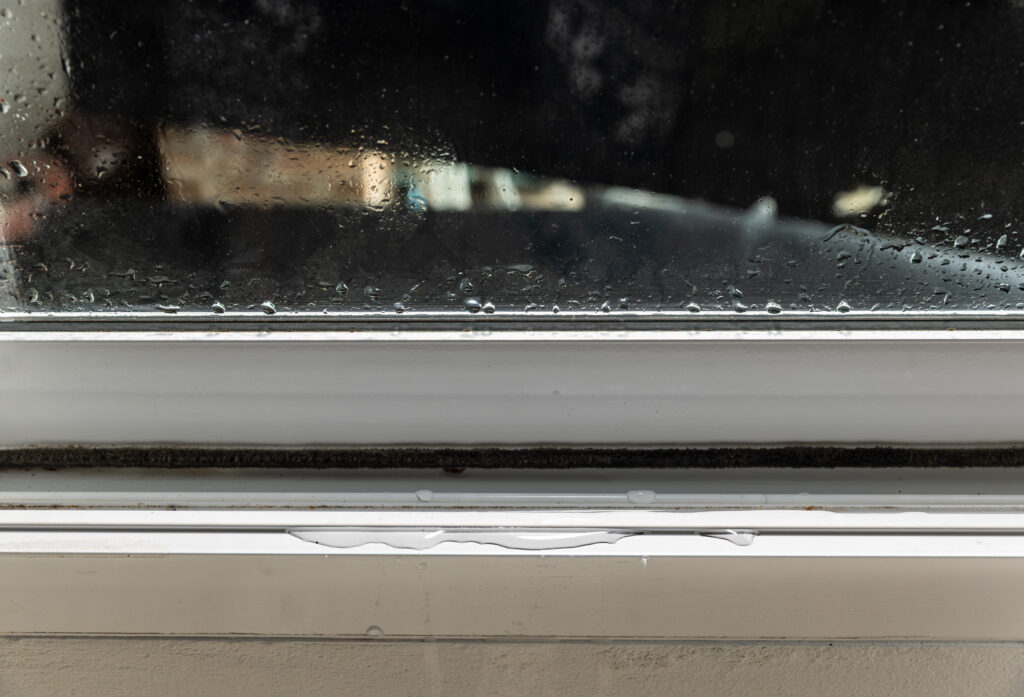
Faulty Windows and Doors
-
- Signs:
-
- Drafts or Cold Spots: Feel for drafts around windows and doors.
-
- Condensation: Water buildup between panes or on sills.
-
- Water Stains: Look for stains on walls or sills beneath windows.
-
- Signs:
- What to Check:
-
- Inspect weather stripping and seals for damage.
- Check for warped frames or improperly installed units.
-

Plumbing Issues
-
- Signs:
-
- Water Stains on Ceilings or Walls: Discoloration can show a leak in the plumbing above.
-
- Damp or Moldy Spots: Unusual moisture near fixtures or on walls.
-
- Unexplained Water Bills: A sudden increase shows a hidden leak.
-
- Signs:
-
- What to Check:
-
- Inspect visible pipes for corrosion or leaks.
-
- Check under sinks and behind appliances for pooling water.
-
- What to Check:

Basement Seepage
-
- Signs:
-
- Musty Odor: Persistent damp smells can show moisture issues.
-
- Cracks in Walls or Floors: Look for visible cracks in the foundation or basement walls.
-
- Puddles or Dampness: Notice any standing water or moisture on the floor.
-
- Signs:
- What to Check:
-
- Inspect exterior grading to make sure water drains away from the foundation.
- Look for signs of soil erosion or pooling around the house.
-
Tips for Effective Leak Detection
-
- Use a Moisture Meter: A tool that measures moisture levels in walls and floors can help find hidden leaks.
-
- Visual Inspections: Regularly check areas prone to leaks, especially after heavy rains or snow melt.
-
- Listen for Sounds: Dripping or running water can show a leak, especially in quiet spaces like basements.
- Check Utility Meters: Watch your water meter for unexplained changes that suggest a leak.
- What to Check:
-
- Inspect seams and joints in the siding for gaps or cracks.
- Check caulking and sealant for wear and tear.
-

Faulty Windows and Doors
-
- Signs:
-
- Drafts or Cold Spots: Feel for drafts around windows and doors.
-
- Condensation: Water buildup between panes or on sills.
-
- Water Stains: Look for stains on walls or sills beneath windows.
-
- Signs:
- What to Check:
-
- Inspect weather stripping and seals for damage.
- Check for warped frames or improperly installed units.
-

Plumbing Issues
-
- Signs:
-
- Water Stains on Ceilings or Walls: Discoloration can show a leak in the plumbing above.
-
- Damp or Moldy Spots: Unusual moisture near fixtures or on walls.
-
- Unexplained Water Bills: A sudden increase shows a hidden leak.
-
- Signs:
-
- What to Check:
-
- Inspect visible pipes for corrosion or leaks.
-
- Check under sinks and behind appliances for pooling water.
-
- What to Check:

Basement Seepage
-
- Signs:
-
- Musty Odor: Persistent damp smells can show moisture issues.
-
- Cracks in Walls or Floors: Look for visible cracks in the foundation or basement walls.
-
- Puddles or Dampness: Notice any standing water or moisture on the floor.
-
- Signs:
- What to Check:
-
- Inspect exterior grading to make sure water drains away from the foundation.
- Look for signs of soil erosion or pooling around the house.
-
Tips for Effective Leak Detection
-
- Use a Moisture Meter: A tool that measures moisture levels in walls and floors can help find hidden leaks.
-
- Visual Inspections: Regularly check areas prone to leaks, especially after heavy rains or snow melt.
-
- Listen for Sounds: Dripping or running water can show a leak, especially in quiet spaces like basements.
- Check Utility Meters: Watch your water meter for unexplained changes that suggest a leak.
- What to Check:
-
- Inspect gutters for debris and clear them regularly.
- Look for sagging sections, which show blockage.
-
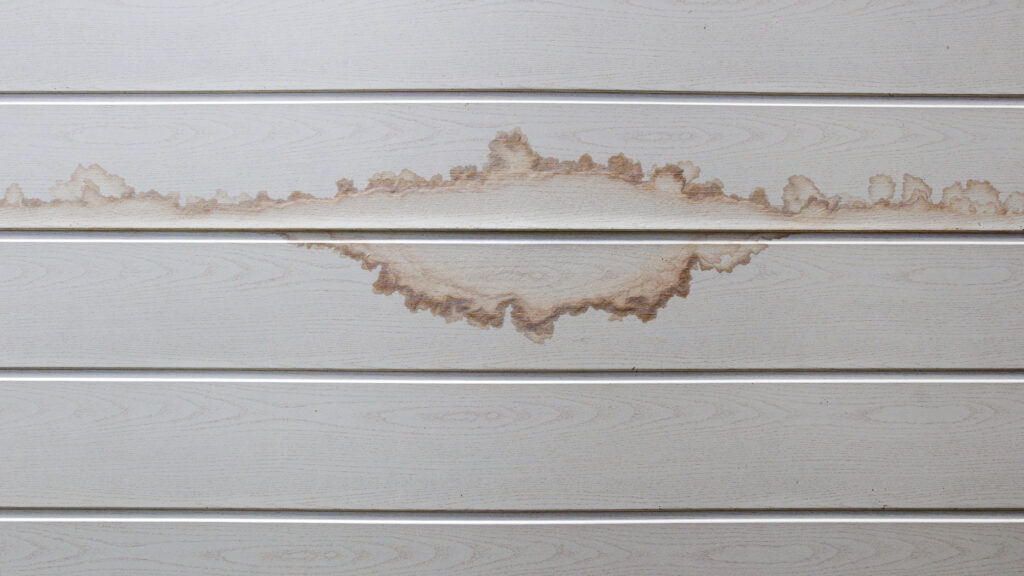
Leaking Siding
-
- Signs:
-
- Discoloration or Stains: Check for water stains on interior walls directly behind the siding.
-
- Peeling Paint or Wallpaper: Bubbling or peeling indicates moisture accumulation.
-
- Mold Growth: Look for mold or mildew in corners and around windows.
-
- Signs:
- What to Check:
-
- Inspect seams and joints in the siding for gaps or cracks.
- Check caulking and sealant for wear and tear.
-

Faulty Windows and Doors
-
- Signs:
-
- Drafts or Cold Spots: Feel for drafts around windows and doors.
-
- Condensation: Water buildup between panes or on sills.
-
- Water Stains: Look for stains on walls or sills beneath windows.
-
- Signs:
- What to Check:
-
- Inspect weather stripping and seals for damage.
- Check for warped frames or improperly installed units.
-

Plumbing Issues
-
- Signs:
-
- Water Stains on Ceilings or Walls: Discoloration can show a leak in the plumbing above.
-
- Damp or Moldy Spots: Unusual moisture near fixtures or on walls.
-
- Unexplained Water Bills: A sudden increase shows a hidden leak.
-
- Signs:
-
- What to Check:
-
- Inspect visible pipes for corrosion or leaks.
-
- Check under sinks and behind appliances for pooling water.
-
- What to Check:

Basement Seepage
-
- Signs:
-
- Musty Odor: Persistent damp smells can show moisture issues.
-
- Cracks in Walls or Floors: Look for visible cracks in the foundation or basement walls.
-
- Puddles or Dampness: Notice any standing water or moisture on the floor.
-
- Signs:
- What to Check:
-
- Inspect exterior grading to make sure water drains away from the foundation.
- Look for signs of soil erosion or pooling around the house.
-
Tips for Effective Leak Detection
-
- Use a Moisture Meter: A tool that measures moisture levels in walls and floors can help find hidden leaks.
-
- Visual Inspections: Regularly check areas prone to leaks, especially after heavy rains or snow melt.
-
- Listen for Sounds: Dripping or running water can show a leak, especially in quiet spaces like basements.
- Check Utility Meters: Watch your water meter for unexplained changes that suggest a leak.
- What to Check:
-
- Inspect gutters for debris and clear them regularly.
- Look for sagging sections, which show blockage.
-

Leaking Siding
-
- Signs:
-
- Discoloration or Stains: Check for water stains on interior walls directly behind the siding.
-
- Peeling Paint or Wallpaper: Bubbling or peeling indicates moisture accumulation.
-
- Mold Growth: Look for mold or mildew in corners and around windows.
-
- Signs:
- What to Check:
-
- Inspect seams and joints in the siding for gaps or cracks.
- Check caulking and sealant for wear and tear.
-

Faulty Windows and Doors
-
- Signs:
-
- Drafts or Cold Spots: Feel for drafts around windows and doors.
-
- Condensation: Water buildup between panes or on sills.
-
- Water Stains: Look for stains on walls or sills beneath windows.
-
- Signs:
- What to Check:
-
- Inspect weather stripping and seals for damage.
- Check for warped frames or improperly installed units.
-

Plumbing Issues
-
- Signs:
-
- Water Stains on Ceilings or Walls: Discoloration can show a leak in the plumbing above.
-
- Damp or Moldy Spots: Unusual moisture near fixtures or on walls.
-
- Unexplained Water Bills: A sudden increase shows a hidden leak.
-
- Signs:
-
- What to Check:
-
- Inspect visible pipes for corrosion or leaks.
-
- Check under sinks and behind appliances for pooling water.
-
- What to Check:

Basement Seepage
-
- Signs:
-
- Musty Odor: Persistent damp smells can show moisture issues.
-
- Cracks in Walls or Floors: Look for visible cracks in the foundation or basement walls.
-
- Puddles or Dampness: Notice any standing water or moisture on the floor.
-
- Signs:
- What to Check:
-
- Inspect exterior grading to make sure water drains away from the foundation.
- Look for signs of soil erosion or pooling around the house.
-
Tips for Effective Leak Detection
-
- Use a Moisture Meter: A tool that measures moisture levels in walls and floors can help find hidden leaks.
-
- Visual Inspections: Regularly check areas prone to leaks, especially after heavy rains or snow melt.
-
- Listen for Sounds: Dripping or running water can show a leak, especially in quiet spaces like basements.
- Check Utility Meters: Watch your water meter for unexplained changes that suggest a leak.

